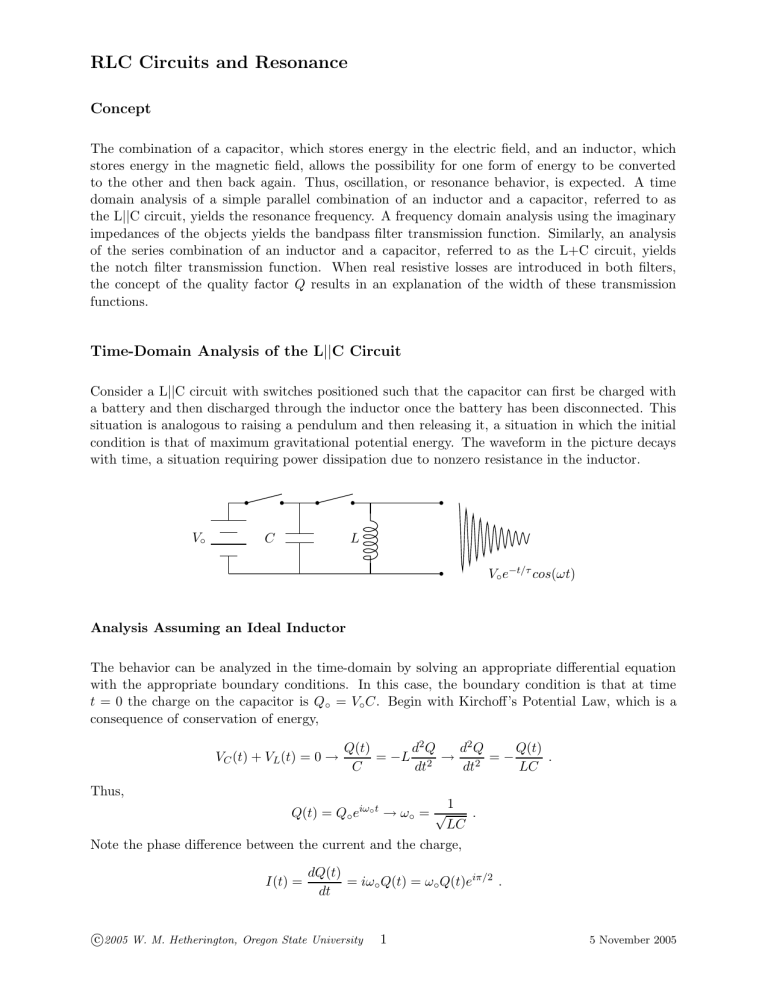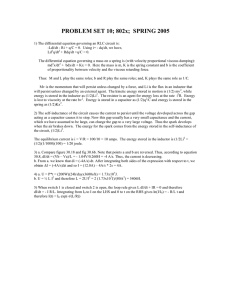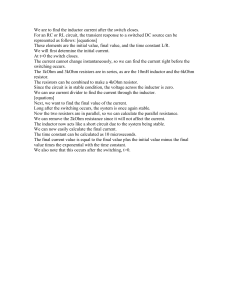Handout on RLC circuits - Department of Physics | Oregon State
advertisement

RLC Circuits and Resonance Concept The combination of a capacitor, which stores energy in the electric field, and an inductor, which stores energy in the magnetic field, allows the possibility for one form of energy to be converted to the other and then back again. Thus, oscillation, or resonance behavior, is expected. A time domain analysis of a simple parallel combination of an inductor and a capacitor, referred to as the L||C circuit, yields the resonance frequency. A frequency domain analysis using the imaginary impedances of the objects yields the bandpass filter transmission function. Similarly, an analysis of the series combination of an inductor and a capacitor, referred to as the L+C circuit, yields the notch filter transmission function. When real resistive losses are introduced in both filters, the concept of the quality factor Q results in an explanation of the width of these transmission functions. Time-Domain Analysis of the L||C Circuit Consider a L||C circuit with switches positioned such that the capacitor can first be charged with a battery and then discharged through the inductor once the battery has been disconnected. This situation is analogous to raising a pendulum and then releasing it, a situation in which the initial condition is that of maximum gravitational potential energy. The waveform in the picture decays with time, a situation requiring power dissipation due to nonzero resistance in the inductor. V◦ C L V◦ e−t/τ cos(ωt) Analysis Assuming an Ideal Inductor The behavior can be analyzed in the time-domain by solving an appropriate differential equation with the appropriate boundary conditions. In this case, the boundary condition is that at time t = 0 the charge on the capacitor is Q◦ = V◦ C. Begin with Kirchoff’s Potential Law, which is a consequence of conservation of energy, VC (t) + VL (t) = 0 → Q(t) d2 Q d2 Q Q(t) = −L 2 → 2 = − . C dt dt LC Thus, 1 Q(t) = Q◦ eiω◦ t → ω◦ = √ . LC Note the phase difference between the current and the charge, I(t) = dQ(t) = iω◦ Q(t) = ω◦ Q(t)eiπ/2 . dt c 2005 W. M. Hetherington, Oregon State University ⃝ 1 5 November 2005 When a real resistance r of the inductor is included, Q(t) will exhibit an exponential decay as well as oscillation, as pictured above. Another initial or boundary condition is that of a nonzero current in the inductor at t = 0. In the picture, the impulse is meant to represent a current in the inductor. This is analogous to hitting a pendulum at rest or ringing a bell. C L V (t) = V◦ e−t/τ sin(ωt) Unit Current Impulse The solution for this initial condition is I(t) = I◦ eiω◦ t and Q(t) = I◦ i(ω◦ t−π/2) e . ω◦ Analysis Assuming a Real Inductor A real inductor exhibits a real resistance r in series with the inductance, so the governing equation becomes Q(t) d2 Q dQ VC (t) + VL (t) + Vr (t) = 0 → +L 2 +r =0. C dt dt Assuming a solution of the form Q(t) = Q◦ eiωt e−t/τ = Q◦ ei(ω+i/τ )t = Q◦ ei(ω+iΓ)t , the equation becomes 1 1 − (ω + iΓ)2 L + i(ω + iΓ)r = 0 → − (ω 2 + 2iωΓ − Γ2 )L + i(ω + iΓ)r = 0 . C C At this point, there are two unknowns, ω and Γ, and two equations, the real and the imaginary parts of the above expression. For the imaginary part, r iωr − 2iωΓL = 0 → Γ = . 2L For the real part, −ω 2 L + Γ2 L − Γr + so ω 2 = Γ2 − 1 =0, C Γr 1 r2 r2 1 1 r2 r2 2 2 + → ω2 = − + → ω = − = ω − = ω◦2 − Γ2 . ◦ L LC 4L2 2L2 LC LC 4L2 4L2 These two results, Γ= yield the solution r and ω 2 = ω◦2 − Γ2 , 2L √ 2 2 Q(t) = Q◦ ei( ω◦ −Γ +iΓ)t . Notice that the frequency of oscillation is now less than that of the ideal oscillator and that the damping or characteristic decay time of the amplitude of oscillation is τ = 1/Γ. c 2005 W. M. Hetherington, Oregon State University ⃝ 2 5 November 2005 Frequency Domain Analysis of the Parallel LC Circuit The fact that an L||C circuit exhibits a natural resonance frequency suggests that its response to a sinusoidal driving signal will depend upon the frequency of that signal. The response should be greatest when the applied frequency is ω ◦ . In this case, response means amplitude of the charge on the capacitor or rate of change of current through the inductor, and a large response means that a large signal will be observed. VR R V◦ C L VL Another view is to use what is referred to as physical reasoning based on the known impedances of the inductor and capacitor. At low frequencies, the inductor is a short circuit, so the output should be about zero. At high frequencies, the capacitor is a short circuit, so the output is again zero. At intermediate frequencies, both the capacitor and inductor have finite, albeit imaginary, impedances, so some finite potential will be measured. A comparison of this view to the previous view suggests that the impedance of the L||C structure is greatest at ω ◦ . Case of an Ideal Inductor Using the device impedances, the total impedance of any portion of a circuit can be easily calculated without having to work with a differential equation. All that is needed is the application of Ohm’s Law and Kirchoff’s Voltage and Current Laws to the circuit. When the input signal V s (t) = V◦ eiωt is applied to the circuit, the potential across the L||C combination is V (t) = ZC||L ZC||L Vs (t) or V (ω)eiωt = Vs (ω)eiωt , R + ZC||L R + ZC||L where Vs (ω) is real and Vs (ω) is complex and 1 ZC||L = 1 1 ZC ZL + or ZC||L = . ZC ZL ZC + ZL We find that, for an ideal capacitor and inductor, ZC||L = iωL iωL = . 1 1 − ω 2 LC iωC( iωC + iωL) Notice that when 1 LC a resonant condition is obtained with Z C||L → i∞. Of course, this is only valid for an ideal inductor. A real resistance r for the inductor will change this result. For an arbitrary frequency ω, ω=√ V (ω) = iωL (1 − ω 2 CL)(R + Vs (ω) iωL ) 1−ω 2 CL c 2005 W. M. Hetherington, Oregon State University ⃝ 3 = iωL Vs (ω) . R(1 − ω 2 CL) + iωL 5 November 2005 This can be rewritten to clearly show the real and imaginary parts by multiply both the numerator and denominator by the complex conjugate of the denomenator V (ω) = ω 2 L2 + iωLR(1 − ω 2 CL) iωL(R(1 − ω 2 CL) − iωL) V (ω) = Vs (ω) . s R2 (1 − ω 2 CL)2 + ω 2 L2 R2 (1 − ω 2 CL)2 + ω 2 L2 The amplitude and phase of the transmission function A(ω) is ! ω 4 L4 + (ωLR(1 − ω 2 CL))2 iβ ω 2 L2 + iωLR(1 − ω 2 CL) V (ω) = = e , A(ω) = Vs (ω) R2 (1 − ω 2 CL)2 + ω 2 L2 R2 (1 − ω 2 CL)2 + ω 2 L2 where the phase is ωLR(1 − ω 2 CL) R = tan−1 (1 − ω 2 /ω◦2 ) . 2 2 ω L ωL β = tan−1 These expression becomes more complicated when Z L = iωL + r is used for the impedance of the inductor. Notice that the |A(ω ◦ )| = 1 and that |A(ω)| → 0 as ω → 0 or ∞. The amplitude and phase of A(ω) are plotted below for the case R = 1000Ω, L = 200µH, r = 0 and C = 1.4µF . Transmission Amplitude of RLC Bandpass Filter L = 200uH r = 0 C = 1.4uF R = 1K Transmission Phase of RLC Bandpass Filter L = 200uH r = 0 C = 1.4uF R = 1K 0 0.4 Phase in units of Pi –10 A(f) in dB –20 –30 –40 –50 –60 –70 0.2 0 –0.2 –0.4 1 2 3 4 5 6 1 log f 2 3 4 5 6 log f Case of a Real Inductor It is perhaps most useful to begin with an analysis of the impedance of the L||C structure, ZL||C = ZL ZC . ZL + ZC For the ideal case, ZL||C = iωL/iωC iωL iωL = = . 2 iωL + 1/iωC 1 − ω LC 1 − ω 2 /ω◦2 As ω → 0, ZL||C → iωL. The phase is α = π/2 for all ω < ω ◦ . As ω → ∞, ZL||C → −i/ωC, and α = −π/2 for all ω > ω◦ . And when ω = ω◦ , |ZL||C | = ∞ and the phase is undefined. For the case of a real inductor ZL = iωL + r and ZL||C = (iωL + r)/iωC r + iωL = z(ω)eiα(ω) , = iωL + r + 1/iωC 1 − ω 2 /ω◦2 + iωrC c 2005 W. M. Hetherington, Oregon State University ⃝ 4 5 November 2005 where √ r 2 + ω 2 L2 ωrC ωL z(ω) = ! and α(ω) = tan−1 − tan−1 . 2 2 2 2 2 2 r 1 − ω 2 /ω◦2 (1 − ω /ω◦ ) + ω r c The maximum value of z(ω) occurs at ω ◦ , " ! r 2 + L/C L L2 z(ω◦ ) = = + 2 2 , ω◦ rC C r C and the phase is ω◦ L π − . r 2 Notice that α(ω◦ ) → 0 as r → 0. As ω → 0, z(ω) → r and α → 0, not π/2 as in the ideal case. As ω → ∞, z(ω) → 1/ωC and α → π/2. α(ω◦ ) = tan−1 The transmission function for the L||C circuit is A(ω) = where z(ω)eiα(ω) z(ω)eiα(ω) z(ω)eiα(ω) ! = = , R + z(ω) cos α + iz(ω) sin α R + z(ω)eiα(ω) R2 + 2Rz(ω) cos α + z 2 (ω) eiβ β(ω) = tan−1 z(ω) sin α . R + z(ω) cos α So, z(ω) A(ω) = ! ei(α−β) . 2 R + 2Rz(ω) cos α + z 2 (ω) The amplitude and phase of A(ω) are plotted below for the case R = 1000Ω, L = 200µH, r = 2Ω and C = 1.4µF . Transmission Amplitude of RLC Bandpass Filter L = 200uH r = 2 C = 1.4uF R = 1K Transmission Phase of RLC Bandpass Filter L = 200uH r = 2 C = 1.4uF R = 1K 0 0.4 Phase in units of Pi –10 A(f) in dB –20 –30 –40 –50 –60 –70 0.2 0 –0.2 –0.4 1 2 3 4 5 6 1 log f 2 3 4 5 6 log f Notice that as ω → 0, A → r/(R + r), that is the curve is flat as shown above. Also, as ω → 0, the phase → 0 since the phase is 0 for a simple resistive potential divider. Frequency Domain Analysis of the Series LC Circuit The same oscillatory behavior occurs in the L+C circuit, as the charge on the capacitor and the current in the inductor alternate. One way to think about this is to consider what happens to the c 2005 W. M. Hetherington, Oregon State University ⃝ 5 5 November 2005 power that you apply to the L+C structure. At ω ◦ , the oscillator will absorb all the power since that is the frequency at which it is most responsive. Thus, the power transmitted through the circuit is small. VR R VL L V◦ VC C The other view is to realize that the impedance of the L+C structure Z L+C = i(ωL − 1/ωC) → ∞ as ω → 0 or ∞ and the input signal is completely transmitted, or |A| = 1. At intermediate frequencies, ZL+C is finite, so |A| < 1. A comparison of this view to the previous view suggests that the impedance of the L+C structure is least at ω ◦ . Case of an Ideal Inductor A thorough analysis begins with V (t) = ZC+L ω2 Vs (t) , where ZL+C = i(ωL − 1/ωC) = iωL(1 − ◦2 ) . R + ZC+L ω Notice that ZL+C (ω◦ ) = 0, as rationalized previously. Then, ω2 iωL(1 − ω◦2 ) ZC+L A(ω) = = . 2 R + ZC+L R + iωL(1 − ωω◦2 ) Thus, ωL(1 − ω◦2 ω2 ) A(ω) = # R2 + (ωL(1 − ωL(1 − ω◦2 ω2 eiπ/2 ω◦2 2 )) ω2 ) A(ω) = # R2 + (ωL(1 − i tan−1 e ω2 ωL(1− ◦ ) ω2 R i(π/2−tan −1 ω◦2 2 ω 2 )) e ω2 ωL(1− ◦ ) ω2 ) R . So |A| → 1 as ω → 0 or ∞. This is the behavior of a notch filter, meaning that it greatly attenuates one particular frequency. This expression for A(ω) is more complicated but more realistic when a inductor resistance r is included. The amplitude and phase of A(ω) are plotted below for the case R = 1000Ω, L = 200µH, r = 0 and C = 1.4µF . c 2005 W. M. Hetherington, Oregon State University ⃝ 6 5 November 2005 Transmission Amplitude of RLC Notch Filter L = 200uH r = 0 C = 1.4uF R = 1K Transmission Phase of RLC Notch Filter L = 200uH r = 0 C = 1.4uF R = 1K 0 0.4 –10 Phase in units of Pi A(f) in dB –20 –30 –40 –50 –60 –70 –80 0.2 0 –0.2 –0.4 1 2 3 4 5 6 1 2 log f 3 4 5 6 log f Case of a Real Inductor The complex impedance of the L+C structure is $ 1 1 ω2 % = r + i(ωL − ) = r + iωL 1 − ◦2 . iωC ωC ω In the limit ω → 0, ZL+C → −i/ωC → ∞, and the phase → −π/2. In the limit ω → ∞, ZL+C → iωL → ∞, and the phase → π/2. At ω = ω ◦ , ZL+C = r, and the phase = 0. ZL+C (ω) = iωL + r + The transmission function of the RLC circuit is $ 2% r + iωL 1 − ωω◦2 ZL+C = A(ω) = $ 2% , R + ZL+C R + r + iωL 1 − ωω◦2 # $ 2 %2 r 2 + ω 2 L2 1 − ωω◦2 eiα A(ω) = # , $ ω◦2 %2 iβ 2 2 2 (R + r) + ω L 1 − ω2 e with ωL $ ω2 % ωL ω2 1 − ◦2 and β = tan−1 (1 − ◦2 ) . r ω R+r ω The total phase is α − β. As ω → 0, this phase → 0. As ω → ∞, the phase also → 0. At ω = ω ◦ , the phase = 0. The amplitude and phase of A(ω) are plotted below for the case R = 1000Ω, L = 200µH, r = 2Ω and C = 1.4µF . α = tan−1 Transmission Amplitude of RLC Notch Filter L = 200uH r = 2 C = 1.4uF R = 1K Transmission Phase of RLC Notch Filter L = 200uH r = 2 C = 1.4uF R = 1K 0 0.4 –10 Phase in units of Pi A(f) in dB –20 –30 –40 –50 –60 –70 –80 0.2 0 –0.2 –0.4 1 2 3 4 5 6 1 log f c 2005 W. M. Hetherington, Oregon State University ⃝ 2 3 4 5 6 log f 7 5 November 2005





